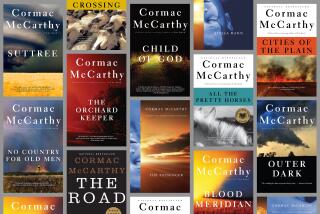Sequels Have Scholars Squirming
- Share via
As scholars cringe, the publishing industry is about to give the world a $4.5-million, 768-page answer to one of the most provocative questions in American letters:
Does Rhett go back to Scarlett?
But “Scarlett: The Sequel to Margaret Mitchell’s Gone With the Wind,” to be published by Warner Books Sept. 25, could also open the floodgates for more sequels to classic works, giving publishing a taste of what Hollywood has known for years: If you have a huge success, milk it.
“Nothing in publishing these days is beyond belief,” said Alan Cheuse, the novelist and National Public Radio book commentator. “Publishing today is as close to literature as the people who made ‘The Terminator’ are to Orson Welles.”
“ ‘Gone With The Wind’ is perfect as it is,” said noted critic Leslie Fiedler. “Certain books should never be finished. I don’t want to know, for example, what happens to Huck Finn after he lights out for the territories.”
Experts say only one person should be able to write a sequel to a classic piece of literature: The person who wrote the original. The common thread among successful sequels, they say, is that they come as part of the original artist’s master plan.
“The problem with a sequel to ‘Gone With the Wind’ is that someone else has to re-create not only the Scarlett-Rhett relationship, but what it was like to be inside the mind of Margaret Mitchell,” said Martha Benta, a professor of English at UCLA.
Although today’s pop authors, such as Danielle Steel, pump out sequels as fast as people can read them, the practice among authors of classics is relatively rare--but it has a long and honorable history:
* Shakespeare’s Richard II was followed by the four Henry Histories, creating one of the richest historical epics in literature.
* Alexandre Dumas picked up the saga of the “The Three Musketeers” 20 years later in--appropriately--”Twenty Years After.”
* Louisa May Alcott’s “Little Men” followed “Little Women” to the delight of readers everywhere.
* William Faulkner’s “Snoop’s Trilogy,” the three John Dos Passos novels bound together as “The USA,” and the John Galsworthy stories composing “The Forsyte Saga” are all noteworthy examples of sequels that work.
As adamant as critics are about adherence to the original-author rule, they tend to approve of two major exceptions: Virgil’s “Aeneid”--the Roman poet’s response to Homer’s “Iliad” and “Odyssey”--and, of course, the New Testament of the Bible.
More to Read
Sign up for our Book Club newsletter
Get the latest news, events and more from the Los Angeles Times Book Club, and help us get L.A. reading and talking.
You may occasionally receive promotional content from the Los Angeles Times.









